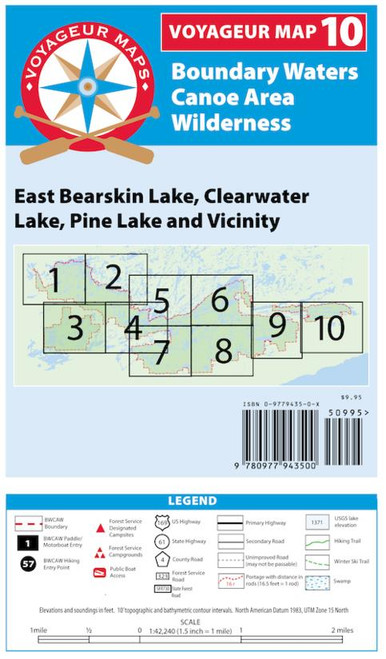Lakes On Map:
Eastern portions of the Boundary Waters Canoe Area Wilderness
- East Bearskin Lake
- Clearwater Lake
- Pine Lake
- Canoe Lake
- Mountain Lake
- Moose Lake
- Daniels Lake
- East Bearskin Lake
- Flour Lake
Entry Points:
- BWCAW canoe entry points 62, 64, 66, 68, 69 and 70
- Hiking - Border Route Trail
Motorized watercraft are allowed within the BWCAW only on Clearwater and East Bearskin lakes, and then only with a 10 horsepower or smaller motor.
Most lakes within the BWCAW on Map 10 are long and thin, stretching from west to east between towering hills of gabbro bedrock. As a result of their shape and orientation, many of these lakes channel westerly winds down their lengths. Larger lakes, such as Mountain, Moose, Pine, and Clearwater are particularly prone to developing big waves when the wind is out of the west. Travel on these lakes is often best undertaken early in the morning before winds pick up.
The geology of this area also heavily impacts portage difficulty. Portages that follow a west-east axis, or connect the ends of lakes, are typically relatively easy. In contrast, portages having a north-south axis are often quite hilly and very challenging.
The most difficult portage on map 10 is certainly the 232 rod portage between Pine Lake and Canoe Lake. This portage climbs over 200 feet in elevation along a switchbacked trail. Fortunately the path itself is relatively smooth.
The Border Route Trail, stretching across Map 10, provides some of the best wilderness hiking in Minnesota. In addition, other hiking and cross country ski trails are maintained along the west end of the Map 10, near Daniels, East Bearskin, and Flour lakes.
Waterproof paper, comes folded
Size:39" x 26.5"
Scale: 1:42,240 (1.5 inch = 1 mile)
The back of all Voyageur maps contains a large, detailed finder map including a thorough index of Boundary Waters lakes. In addition, information about navigation in the Boundary Waters, safety, rules & regulations, basic entry point information, hiking opportunities, winter activities, fishing, and sources for further information is provided.
The overview map is a great asset for trip planning, but has been simplified to an extent that it is not suitable for navigation. In addition, campsite locations are not as carefully reviewed as those shown on the detailed fronts of each Voyageur map.


